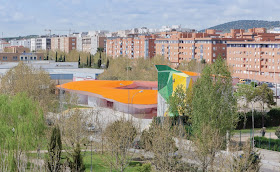I made an excursion to the Directed Settlement of Almendrales in Madrid today, and took a few pictures. I was able to get into the hypostyle church, with its slender columns and skylights, inspired in the "multi-polar" spaces of a mosque, and inspiration in turn, no doubt, for Rafael Moneo's Atocha Railroad Station. The columns double as rain gutters.
The housing was built by the Franco regime to replace shanty towns that sprang up around Madrid in the 1950s (see my related article on the Directed Settlement of Caño Roto).
 |
| Church (1961-64) José María García de Paredes |
 |
| Settlement (1958 - 1964) Ramón Vázquez Molezún José Antonio Corrales Javier Carvajal José María García de Paredes |
Warm, rough, simple brick, regular orientation to the light (evident in these pictures) without a sense of repetition, due to the rippling setbacks of the housing blocks.
Suppression of regular street grid for parking cul-de-sacs and green spaces, now with mature trees.
Low buildings for local shopping along one of the streets, and a kind of market in one area.
The openness and trees, the light and reflected light from the brick, set the district apart from its surroundings.
Many blocks have been renovated and finished in stucco. Otherwise the complex is remarkably preserved. The access to the church has been changed, and the covered porch along one side of the patio, and connecting the church to the parish house, has disappeared. But the patio's Mediterranean pines make up for this loss, I think.
 |
| Approach to the church (left) |
Church plan:
Colegio Oficial de Arquitectos de Madrid, J. M. García de Paredes Arquitecto (1924 - 1990), COAM, Madrid, 1992, page 71.
The best site plan I could find so far. Top of plan is north:
Luis Moya González, Barrios de Promoción Oficial. Madrid 1939 - 1976, COAM, Madrid, 1983, page 212.
Location: Metro Almendrales
The settlement runs along the Avenida de Córdoba, the old highway route to the south, on the western side of the Manzanares River just south of the Legazpi Bridge.
Typical floor plan for the blocks:
Fundación COAM, Ramón Vázquez Molezún, Fundación COAM, Madrid, 2006, page 104.
From the Legado Vázquez Molezún















































